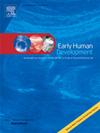手指比例(2D:4D)是女性乳酸水平的生物标志物吗?来自职业女足球运动员心肺测试的证据
IF 2.2
3区 医学
Q2 OBSTETRICS & GYNECOLOGY
引用次数: 0
摘要
乳酸和手指比例(2D:4D)与运动表现、心血管疾病和某些癌症有关。2D:4D在不同跑步速度的男性运动过程中与乳酸呈强烈正相关。本研究旨在探讨女性在心肺运动试验中2D:4D与乳酸之间的关系。方法调查对象为职业女足运动员。跑步机测试以6公里/小时的速度开始,每3.15分钟增加2公里/小时,测量速度为6、8、10、12和14公里/小时。结果白种人25人,黑人3人;后者的2D:4D和乳酸水平较低,但样本量太小,无法进行有意义的比较。乳酸水平随着跑步速度的增加而增加。在6 ~ 12 km/h时,2D:4D与乳酸无关。在14 km/h时,乳酸与左右2D:4D呈正相关(前者更强),与身高和手指长度呈负相关。这些相关性对整个样本和白种人都是显著的。高加索样本的多元回归表明,在14 km/h时,右2D:4D与乳酸含量呈正相关,在所有速度下,身高与乳酸含量呈负相关。在运动过程中,女性的2D:4D与乳酸之间的关系的效应量为正,但小于男性,并且仅限于较高的跑步速度。与男性不同,女性的身高和乳酸含量呈负相关。产前和青春期的性类固醇效应可能解释了这些性别差异。本文章由计算机程序翻译,如有差异,请以英文原文为准。
Is digit ratio (2D:4D) a biomarker for lactate in women? Evidence from a cardiopulmonary test on professional female footballers
Background
Lactate and digit ratio (2D:4D) have been linked to sports performance, cardiovascular disease, and some cancers. 2D:4D is strongly and positively associated with lactate during exercise across a range of running speeds in men. This study aimed to consider the relationship between 2D:4D and lactate in women during an incremental cardiopulmonary exercise test.
Method
The participants were professional female football players. The treadmill test began at a speed of 6 km/h and was increased by 2 km/h every 3.15 min, with measurements at 6, 8, 10, 12, and 14 km/h.
Results
There were 25 Caucasian and 3 Black participants; 2D:4D and lactate levels were lower in the latter, but the sample size was too small for meaningful comparisons. Lactate levels increased with running speed. The 2D:4D was not associated with lactate at 6 to 12 km/h. At 14 km/h, lactate was positively associated with right and left 2D:4D (stronger for the former) and negatively with height and digit lengths. These correlations were significant for the total sample and Caucasians only. Multiple regressions for the Caucasian sample showed that right 2D:4D was positively related to lactate at 14 km/h, and height was negatively associated with lactate at all speeds.
Conclusion
During exercise, the effect sizes for relationships between 2D:4D and lactate in women are positive but smaller than those reported for men and restricted to higher running speeds. Unlike men, women show a negative relationship between height and lactate. It is suggested that prenatal and pubertal sex steroid effects may explain these sex differences.
求助全文
通过发布文献求助,成功后即可免费获取论文全文。
去求助
来源期刊

Early human development
医学-妇产科学
CiteScore
4.40
自引率
4.00%
发文量
100
审稿时长
46 days
期刊介绍:
Established as an authoritative, highly cited voice on early human development, Early Human Development provides a unique opportunity for researchers and clinicians to bridge the communication gap between disciplines. Creating a forum for the productive exchange of ideas concerning early human growth and development, the journal publishes original research and clinical papers with particular emphasis on the continuum between fetal life and the perinatal period; aspects of postnatal growth influenced by early events; and the safeguarding of the quality of human survival.
The first comprehensive and interdisciplinary journal in this area of growing importance, Early Human Development offers pertinent contributions to the following subject areas:
Fetology; perinatology; pediatrics; growth and development; obstetrics; reproduction and fertility; epidemiology; behavioural sciences; nutrition and metabolism; teratology; neurology; brain biology; developmental psychology and screening.
 求助内容:
求助内容: 应助结果提醒方式:
应助结果提醒方式:


